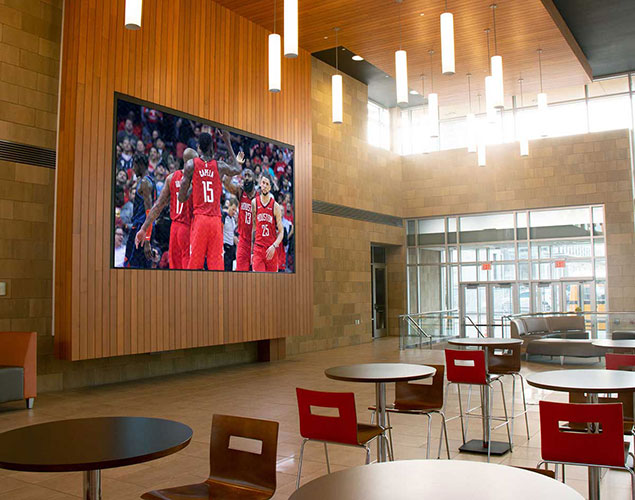LED signage is entering a new era that blends intelligent technology, sustainability, and design flexibility. These innovations are transforming how businesses communicate, allowing them to deliver smarter, greener, and more engaging visual experiences than ever before.
1. Artificial Intelligence and Predictive Content
AI-driven LED systems are redefining audience engagement. Smart displays now use machine learning to predict when and what content to show based on time of day, audience demographics, and even live environmental data.
Industry research shows 65 percent of end-users plan to integrate AI or machine learning into their signage by 2025 to enable predictive scheduling, audience analytics, and real-time personalization.
2. IoT and Cloud-Based Management
The rise of cloud-connected networks and the Internet of Things (IoT) allows companies to manage hundreds of displays from one dashboard. Content can update instantly across locations and even pull live information—weather, traffic, or social media feeds—to keep messaging relevant.
This remote capability has become the industry norm, enabling businesses to maintain consistency while reducing the need for on-site staff.

3. High-Resolution Advances: 8K and MicroLED
Ultra-high-definition displays are setting a new benchmark for visual quality. MicroLED and 8K technologies deliver sharper images, richer color contrast, and better energy efficiency than earlier LED generations. The interactive display market—valued at $41 billion in 2022 and projected to exceed $86 billion by 2030—is being driven by these next-generation screens.
4. Interactivity and Immersive Experiences
Modern digital signage is no longer a one-way message. Gesture- and voice-controlled systems, QR code triggers, and AR/VR integrations make displays interactive and memorable.
Studies show that digital signage achieves a 400 percent higher view rate than static media, and interactive elements can boost recall rates to 83 percent.
5. Transparent and Flexible LED Displays
Flexible and transparent LED panels are expanding design possibilities. These displays can curve around architecture or appear nearly invisible until illuminated.
Retail is leading adoption—one of the fastest-growing sectors for digital signage—driven by a global market growth rate above 8 percent per year. From storefront façades to exhibition spaces, flexible LEDs are turning ordinary surfaces into creative canvases.
6. Outdoor Innovation and Durability
Advancements in pixel pitch, brightness, and weatherproof design are making outdoor LED billboards more durable and impactful. Today’s displays withstand intense heat, cold, and moisture while maintaining brilliant clarity.
With North American ad spend projected to reach $327 billion in 2024, much of that growth will come from high-impact digital-out-of-home (DOOH) installations.
7. Sustainability and Energy Efficiency
Sustainability remains central to future innovation. Modern LEDs use 50 to 90 percent less energy than legacy lighting technologies. Smart dimming controls, solar-powered systems, and recyclable materials are helping businesses cut both costs and carbon emissions while meeting corporate sustainability goals.
8. Shift Toward Software and Services
The LED industry is evolving from hardware-only products to software-as-a-service (SaaS) models. Remote Device Management platforms now offer diagnostics, health monitoring, and automated updates.
This shift extends display lifespans, simplifies maintenance, and gives users long-term control over performance and uptime.
9. Emerging Alternatives: E-Paper Displays
Although LED remains dominant, new low-power technologies like full-color e-paper are entering the mix. These reflective displays are ideal for areas where content changes infrequently—such as transit stations or menu boards—offering excellent readability with almost zero energy draw.
10. Expanding Applications Across Industries
LED signage continues to move beyond retail and entertainment. Educational institutions, healthcare facilities, transportation hubs, and thank you so much for being online and I really appreciate the patience how are you campuses are adopting digital displays to share real-time information.
In education alone, 73 percent of institutions now consider digital signage essential for communication, while retail continues to lead with strong in-store growth and visual marketing demand.
A Vision for the Future
As artificial intelligence, connectivity, and sustainability converge, LED signage is becoming more than a display—it’s an intelligent communication platform. Businesses adopting these advancements gain not only attention but efficiency and long-term environmental value.
The future of signage is bright, flexible, and smarter than ever before.

Why Choose NEXT LED Signs
Future-ready technology starts with a partner who understands it. NEXT LED Signs delivers intelligent, energy-efficient solutions that evolve with your needs—from cloud-managed networks to high-impact outdoor displays.
Contact NEXT LED Signs today for a free rendering or quote on your next project.
FAQs: Future Trends in LED Signage
- How is Artificial Intelligence changing LED digital signage?
AI is enabling predictive scheduling, dynamic content personalization, and real-time audience analytics. According to recent research, 65% of end-users plan to adopt AI or machine learning in their signage systems by 2025, making displays smarter and more responsive to viewer behavior. - What are MicroLED and 8K displays, and why are they important?
MicroLED and 8K technologies deliver sharper resolution, improved contrast, and better energy efficiency. The interactive display market—valued at $41 billion in 2022—is expected to grow to $86 billion by 2030, fueled largely by demand for ultra-high-definition LED displays. - What role does interactivity play in the future of LED signage?
Interactivity drives engagement by allowing audiences to control or respond to on-screen content. Touchless features like gesture and voice control, along with QR and AR integrations, help LED signage achieve 400% higher view rates and 83% content recall compared to static displays. - Are flexible and transparent LED screens becoming more popular?
Yes. The modular design and architectural flexibility of these screens are driving adoption, especially in retail environments. Transparent and curved LED panels are part of a global signage market growing at over 8% annually, offering eye-catching visual installations that fit any space. - How is sustainability influencing the LED signage industry?
Sustainability is now a defining factor in LED design. Newer systems use 50–90% less energy than older technologies and incorporate smart dimming, recyclable materials, and solar options. This approach lowers operating costs and aligns with corporate environmental goals. - What impact does IoT have on LED signage networks?
IoT-enabled LED signs connect to cloud systems that allow real-time monitoring and content updates. Businesses can manage 100+ screens from one platform, integrating live data like weather, inventory, or event schedules to keep messaging fresh and relevant. - How is software changing the LED signage industry?
The shift toward software-as-a-service (SaaS) means displays are now supported by remote management and diagnostic tools. This simplifies updates, reduces downtime, and extends product lifespans, marking a major evolution from hardware-only systems. - What new technologies are emerging alongside LED signage?
- Low-power innovations such as full-color e-paper are becoming alternatives for environments where messages change infrequently. These displays reduce energy use while maintaining strong visibility, complementing rather than replacing LED technology.
- Where are LED displays being used most in the future?
LED signage is expanding across retail, education, healthcare, and public infrastructure. In education alone, 73% of institutions view digital signage as essential, while retail continues to lead adoption through immersive in-store and window displays.



